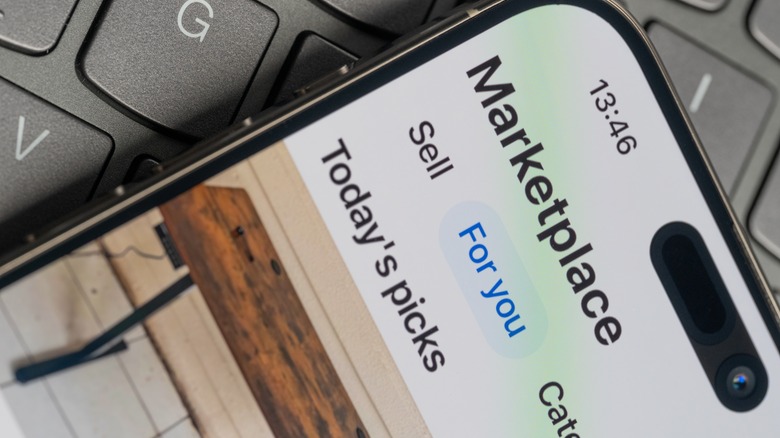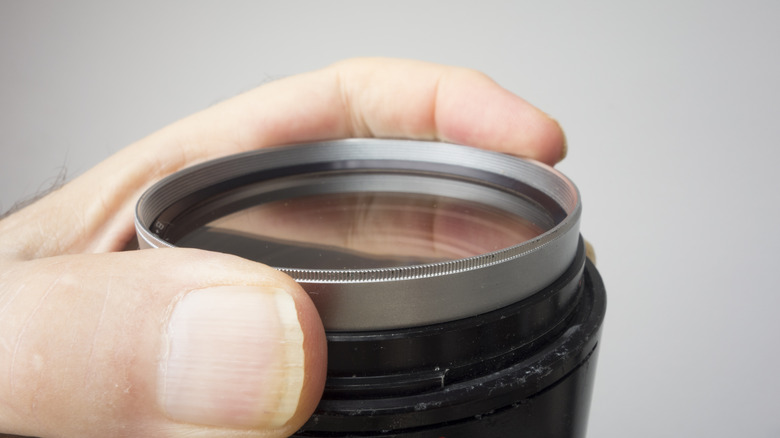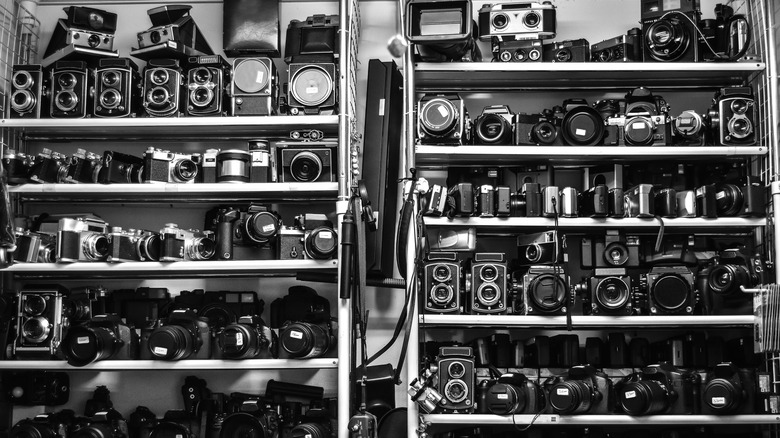6 Things To Look For When Buying A Used Camera Lens
We may receive a commission on purchases made from links.
When it comes to photography, the right lens can make all the difference. You can improve how wide the angle of the photo is, how crisp it is, the vibrancy of the colors, and more. In many ways, camera lenses can help define not just the quality of your photos, but also the distinct style and mix of elements. We've argued before that instead of an upgrading your camera body, a new lens can make a bigger difference. To help you choose the right lens, we've already narrowed down our suggestions for essential camera lens models for photographers, which includes necessities like the zoom lens, telephoto lens, and prime lens. Although, anyone who has tried to invest in cameras lenses will know the unfortunate truth that it can get expensive. In fact, some camera lenses can go for hundred of thousands of dollars.
Unlike buying a brand-new camera lens from a store, purchasing a secondhand camera lens isn't as straightforward. After all, there are fewer protections in place against scammers, bad actors, or simply uninformed sellers. Ideally, you should also already have the model in mind, so you can put more of your energy into verifying if the specific lens is still up to standard. So, if you're serious about getting a secondhand lens to join your photography kit, here are a couple of things you should pay attention to prevent any problems.
Vet the seller's profile
One of the common challenges you can expect to experience when buying a secondhand camera lens is making sure the seller is legit. When you're buying from a physical store, you'll want to watch out for things like business permits, official receipts, and other forms of documentation that they're a legitimate business. If possible, try to confirm if they also have a limited seller warranty, which can be useful if you discover issues with your camera lens later on. On the other hand, when purchasing from an online retail store, you'll need to be wary about buying from a scam website by checking things like URLs or the website content for any sketchy clues.
If you're buying directly from another user on dedicated selling platforms, like Craigslist or eBay, it's also a good idea to check their seller history, as well as ratings from previous buyers. Plus, it won't hurt to check out our Facebook Marketplace buying guide to manage your expectations. Lastly, if you're buying from unofficial platforms like Instagram pages, you'll want to consider other forms of social proof like testimonials from past customers, proof of delivery, or profile verification. When meeting sellers you don't know personally, keep yourself and your personal data safe by not giving your full name or personal home address. Instead, opt to meet in public places or dedicated internet purchase exchange locations in your local area instead, where you'll have the buffer of other people when you make your deal.
Verify lens legitimacy
Once you've verified the seller, the next step is to make sure that the lens itself is legitimate. In general, imposter lenses are not as ubiquitous as counterfeit camera batteries or chargers, for which Sony and other brands have issued official notices. However, there is still some evidence that they exist, especially when it comes to expensive models. For example, Canon has issued a service notice regarding imposter versions of its EF 50mm F1.8 II lenses. The camera manufacturer discovered these counterfeit lenses when several people brought their cameras to official service centers. That said, it's important to note that not everyone who is selling their lens will be able to confirm whether they are real or not, especially if they're not photographers themselves.
In some cases, counterfeit lenses can look almost identical on the outside, but have different internal components that did not undergo the same rigorous quality testing and safety standards. After some time, this can lead to unwanted damage to your camera body. To avoid accidentally buying counterfeit products, it is best to request a proof of purchase from the original owner. Whether bought online or in-store, they should ideally be able to produce the accompanying printed receipt, original box, and warranty card. Alternatively, if they're unable to provide this, you can also opt to visit the official websites of the camera lens manufacturers and compare the close up photos to the actual item you are trying to buy.
Check for physical damage
If you're more or less convinced that the pre-owned lens in your hand is legitimate, the next step is to check if it looks like it is already on its last legs. In order to make a quick buck, some sellers might not be dishonest with the actual condition of their lens and are hoping buyers don't notice. Or, it's also possible that they're not aware of how damaged their item really is. Because of this, it's important to take time to check for any physical damages, such as cracks or scratches. While some scratches can be superficial or only cause minor inconveniences, such as those from cleaning marks, larger ones can impact the image quality for some shots. If you can point out how it can impact the shooting experience, some sellers will be keen to make some price adjustments.
But, if a smooth-looking lens isn't a priority, it's okay to haggle down the cost of your purchase based on cosmetics issues alone. That said, there are some physical issues that should trigger a few alarms in your head. For example, you'll want to check the mount contact points for any red flags, like scratches. In the best-case scenario, these can affect the stability of your camera's communication to the lens, which you can decide if a dealbreaker or not. But in the worst case, such as with bends, it can lead to unwanted damage to your camera body's contact points as well.
Examine the lens filter threads
Previously, we've mentioned how filters fulfill a dual function for camera lenses and can make your camera last longer. First, it lets you control the amount of light that passes through it, which adds a distinct character to photos due to slight changes in color. In the past, we've even narrowed down some of the best filters for astrophotography. Second, it quite literally protects your camera lens from the elements, as well as unexpected falls. Acting like a sort-of screen protector, it's essentially putting a physical barrier between your sensitive lens and the rest of the world. That is, if your used camera lens doesn't have issues attaching it.
For photographers who believe in using filters, you'll want to check the filter threads on the secondhand camera lens you're planning to buy. If the threads are damaged, it's possible for filters to get stuck on the lens and cause even more problems. However, if the filter threads are the only thing standing in the way of a really good deal on an otherwise expensive camera lens, there's still hope. On Amazon, you can get the Neewer Camera Lens Vise Repair Tool, which sells for only $33.04 with an average of 4.3 stars from over 300 reviewers. The repair tool is capable of repairing not just the threads (27mm to 130mm), but also minor dents and edges problems.
Inspect for mold & dust
Similar to when you're buying a 35mm camera, you'll need to watch out for dust and fungus buildup inside a used camera lens. Typically, fungus appears like spider-like webs that appear at the edge of the lens. To check if it has fungus, use a small flashlight and shine it through the back of the lens to reveal any imperfections. If you want to be extra thorough about it, you can also use your mobile phone to get a better view of the inside of the lens as well.
Although, if the price is low enough, you could also factor in the cost of buying a lens cleaning kit. On Amazon, one popular option is the Zacro 14-in-1 camera lens cleaning kit, which includes tools like blowers, detergent, swabs, and cleaning pens that come in a convenient storage bag. Selling for $21.99, over 7,000 people have given the Zacro 14-piece cleaning kit an average of 4.6 stars. But, if you do decide to take this route, don't forget to read our tips for cleaning camera lenses to avoid damaging it further.
If you want to store your lens correctly and avoid this happening in the future, you can also invest in a lens cabinet that can keep dust away while also having dehumidifying capabilities, such as the Ruggard Electronic Dry Cabinet. As of writing, over 300 people think it's a good deal and have given it an average of 4.5 stars, with prices starting at $149.95.
Make sure the features work
Last, but arguably the most important part, is testing the camera lens features to the best of your ability. To do this, you'll need to have your actual camera body on hand. In some cases, you may also need to purchase an additional adapter to be able to mount it properly. Once it's successfully mounted, you'll want to pay attention to the smoothness of the zoom and focus ring movement. If it's still working well, you won't hear any clunky sounds or feel like you're dragging the ring through cobblestone.
Next, you can do various test shots to evaluate the quality of things like autofocus, distortion, or sharpness, as well as its performance in low light conditions. Obviously, if you haven't owned the specific lens before, it can be difficult to know if it's performing up to standard. But if a physical store is accessible to you, you can also test the guaranteed new and original lens beforehand, so you can better compare the quality with the same camera body.
That said, buying any sort of secondhand electronics is always a risk. After all, unless you're buying from a reputable secondhand or used retail chain, there is often no or limited warranty. Alternatively, you may want to consider getting a cheap camera lens instead of buying secondhand. These days, there are plenty of options available from most of the major camera lens manufacturers that can fit most budgets or installment plans at your disposal.






